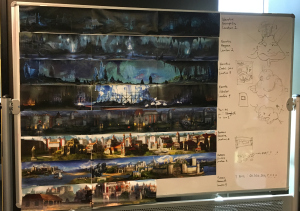I had the opportunity to spend over an hour with Ben Stoll (Director of Game Theory, Hex Entertainment) to discuss the difference between PvP and PvE. With a team of nine fellow designers, each with their own strengths, he corrals everything together and ensures that the fun isn't lost in the design structure. As technology has changed, data analytics have become an important metric for game designers, but they can't overshadow their other tools or the game becomes a mechanic to simply wring the most money out of a player. The morality of how to engage a player without creating a negative environment, without creating an addiction to the high of winning in a cruel fashion, was very important to the HEX team. So instead of training the players to want what HEX provides, the HEX team uses the feedback they receive regularly to be appealing to multiple types of players — whether their primary interest in the game is winning PvP battles, collecting all the cards, or experiencing the game's lore.
With the launch of the PvE campaign, HEX has realistically become two games. In fact, players who do not enjoy PvP will never have to play a single game against another person; on the flip side, players who have no interest in PvE do not need to run the campaign. Items that are acquired solely through one side or the other can be purchased through the auction house, which requires gold (in-game currency that is earned at a steady rate in both PvP and PvE) or platinum (purchased with real money). Players will not "miss out" on items exclusive to either if that is their preference. In addition, players who have already invested time or money in the game can use their existing cards in the PvE mode, albeit with some limits (and with some levels designed specifically for these types of players). The hands-on impression goes deeper into how this works.
A staggered work flow also allows the design team to be "ahead" of the rest of the team — with Set 4 nearing completion, Set 5 is already well underway, travelling ever onwards to the next set of folks that will make it a reality. This flow of work also applied to the PvE campaign, where cards were printed out, tested, and weighted against current content. Playtesting allowed the team to identify cards that would create a unique PvE experience but would not fit well within the PvP world and decide how to handle them well before they're entered into the game.

|
With the addition of the new PvE mode, the team also went back and took a hard look at their introductory tutorial, which every player must play through before being let loose onto the game. Now the tutorial has had a complete overhaul in how it handles training players based on their past experience level, and now guides them into the various game modes so that they aren't simply dumped into a main menu, and instead are guided towards gameplay modes including both PVP and PVE.
One of the biggest design challenges that the team ran into was how to create four introductory fights that the player is intended to win without them being predictably guaranteed to win or worse, boring. In order to accomplish that, the team designed fights that put immediate pressure of some fashion on the player; whether it be the way the opponent was drawing cards, to what they were able to play in early game, what inherent bonuses the PvE map applied to the match, to cards that began on the board. While it is possible to fail these fights, the advantage is generally on the player's side as these fights are important teaching moments. However, these are not stacked decks; in other card games it's not unusual to draw cards in a pre-arranged order to provide players with a pivotal card on a certain turn. HEX does not pre-arrange the card draws, teaching players to work with what they have.
Despite being an exclusively digital card game, when designing new features, cards, and sets the staff still prints them out and plays them like a traditional physical card game; this lets them run rudimentary tests for how a system might function before handing it to the programmers to add to the game, where additional testing takes place to balance the new cards and functions against existing gameplay. Good thing they're not making a first person shooter!
|









